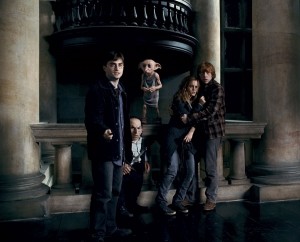The beginning of the end
Fans, relax — it’s not the end of Harry Potter yet.
The seventh and final installment of the Harry Potter series, Harry Potter and The Deathly Hallows, directed by David Yates, was released on Friday — but only the first part of it.
Whether financially or creatively motivated, the decision to split the final book of J.K. Rowling’s famous wizarding tales into two parts was a wise one. After all the dramatic buildup to this final climax, it would only be an injustice to the books and fans to rush through the finale to this series, especially when it wields the darkest and most complex moments throughout the history of Harry Potter.
Harry Potter and The Deathly Hallows Part 1 is not a happy movie.
Gone are the charming wonders of the magical world, along with its curious and delightful chocolate frogs and Bertie Bott’s beans. Gone is the excited gaggle of students gossiping within the warm castle walls of Hogwarts, the beloved school of witchcraft and wizardry. And gone is the reassuring, safe presence of headmaster Albus Dumbledore.
Instead, a dark, moody tone shrouds the entire atmosphere. Even the numerous landscape scenes, though vast and beautiful, are shot under a gloomy, overcast sky that seems to swallow the small figures of the characters.
In fact, the film’s plot centers on the juxtaposition of three bewildered teenagers — Harry (Daniel Radcliffe), Hermione (Emma Watson) and Ron (Rupert Grint) — in a big, scary world that crushes them with the responsibility of defeating the evil, power-hungry Voldemort.
The story picks up right where it left off in Harry Potter and The Half-Blood Prince (2009): Voldemort is back, and his plans have never been more evil. And of course, Harry tries to save the day.
The only way he can do that is by tracking and destroying all of Voldemort’s seven Horcruxes — the random objects in which Voldemort preserved part of his soul to ensure eternal life. The problem is that Harry doesn’t have a clue what those Horcruxes are, where to find them or how to destroy them.
Talk about mission impossible.
Meanwhile, Voldemort has dispatched his minions, the Death Eaters, to hunt Harry down so that he can finish Harry off himself — including anybody who dares to help him.
That leaves Harry twisted by guilt, which is just one of the many conflicted emotions anchoring him as he embarks on his mission. Day by day, he struggles with mounting fear, loss, confusion and frustration, and — worst of all — moments of doubt and disillusionment toward Dumbledore, the figure he once so admired and loved.
The storyline and production setting takes on a stronger political motif and makes allusions to George Orwell’s 1984 and the Nazis by further revealing government corruption and unethical media practices. Wizards and witches are dragged down to be interrogated about the purity of their magic blood and their loyalty to Voldemort.
Despite all the maiming and murders, the story plods at a much slower pace than the previous movies. This detailed narrative might seem tedious to an audience who wants constant excitement, but fans who have always been more interested in the stories behind the characters will relish seeing some issues being addressed that otherwise have only been hinted slightly on other films; namely, the sensitive relationship between Hermione, Harry and Ron.
What makes this film so different from the previous ones is that these three characters are finally given the chance to shine. Ever since Harry Potter and the Sorcerer’s Stone (2001), the young actors playing the leads have always been overshadowed by the colorful performances of their supporting actors, who are mostly well-known and accomplished British thespians.
But these lead actors have grown up. After almost a decade of working with an experienced acting crew, they are now ready to hold their own stage — and they nail it.
The awkward, comical antics, the fits of high school jealousy and resentments, the flashes of sweet budding romance are played out skillfully and seamlessly by these young actors. And thus they manage to successfully capture the audience’s heart and attention in their characters’ personal development.
As a package, this film lacks a lot of details and explanations as compared to the book. Avid fans will notice that there are a few scenes missing, but within the 146 minutes of screen time, the director uses each minute well, paying sensitive attention to even the minor scenes, and leaving no clutter behind.
With haunting, thrilling visuals, foreboding symbols and endearing character developments, Harry Potter and the Deathly Hallows Part 1 sets an appropriate preparation for a stunning finale,.Unfortunately, we’ll have to wait until July for that.

